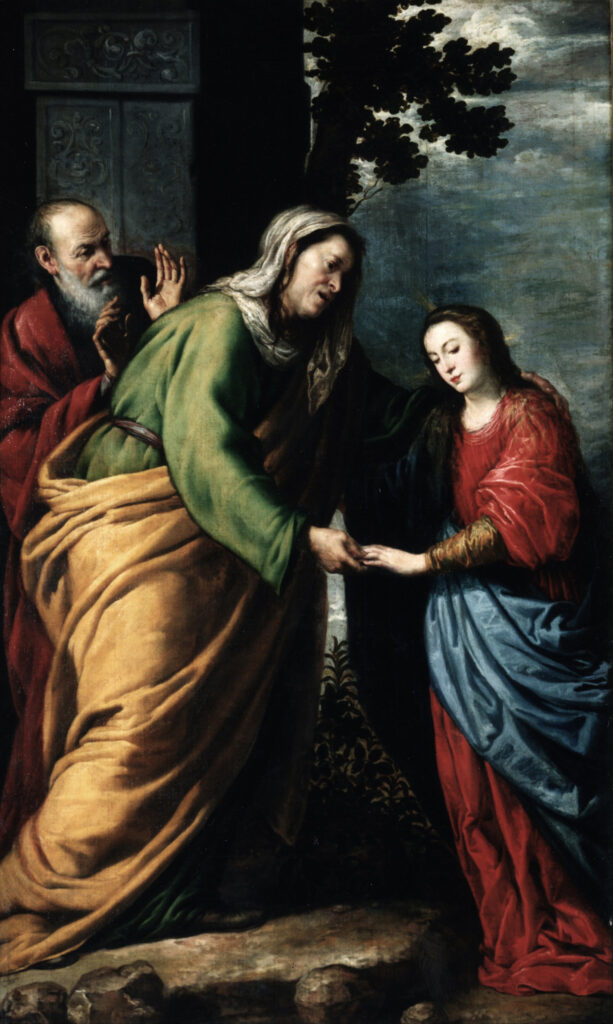The Gospel of Luke, starting in chapter 1 verse 39, tells the story of Mary, pregnant with Jesus, visiting her cousin Elizabeth who was also pregnant with John the Baptist. The libretto for Cantata 147, which we discussed in our last session, is based on the first part of this narrative. Elizabeth blesses Mary upon hearing the news of her pregnancy, and Mary’s response is known as “The Magnificat”, or the Song of Mary (verses 46 – 55).
The Magnificat is one of the most ancient Christian hymns, and it has been set to music innumerable times. Several of those compositions may have been known by Bach, including the one composed by Kuhnau, his predecessor in Leipzig, and by Graupner, who competed with him for the post of Cantor using his own setting of the Magnificat as an audition piece.
The Magnificat is often sung at Christmas, and going into his first one in Leipzig, in 1723, Bach composed the Magnificat in E flat major, BWV 243a, which is the first version of the work. In it, the Latin text is augmented with four interpolations (or “Laudes”) from German hymns that refer to different aspects of the Christmas feast.
In later revisions, Bach made some changes – he transposed the piece from E flat to D, possibly to accommodate the trumpets, replaced the recorders with traverse flutes, and removed the “Laudes”, leaving only the original Latin text of Luke’s gospel. This made the work suitable not just for Christmas but also for the feast of Visitation, which commemorates Mary’s visit to Elizabeth and was celebrated in early July in Bach’s time. Scholars believe that this adaptation was made for a first performance in 1733.
In its final form, the scoring includes 3 trumpets, timpani, 2 flutes, 2 oboes/oboes d’amore, strings and continuo (including cello, violone and bassoon). From a vocal perspective, 5 solo voices are required (two sopranos, alto, tenor and bass) as well as a 5-part choir (SSATB).

Bach’s Magnificat has 12 movements. The first 11 deliver the full text of Mary’s song, and the last one is set to the “Gloria Patri” doxology. There are no recitatives, and none of the arias are “da capo”. The first, 7th and last movements are for “tutti” forces – full orchestra and choir. Between them, there are 5 solo arias (one for each soloist) with different instrumentations, one duet, and one trio, plus two additional choral movements.
The opening movement begins with an instrumental ritornello, which lasts for 30 bars, before the choir comes in in pairs (SS, then AT, then B) with the motif over the word “Magnificat”. The voices interplay with the short text of the first verse, before converging on the final utterance of the word “Dominum”, after which the orchestra closes with a postlude.
Soprano II takes the next line, “Et exsultavit”, illustrating the joyful text accompanied by the strings and continuo. Soprano I is in charge of the next verse, “Quia respexit”, with a beautiful adagio accompanied by oboe d’amore and continuo. In a remarkable example of text interpretation, the aria leads straight into a massive and virtuosic chorus, “Omnes generationes”, to deliver the last two words of the verse as a way to impart the dimension of the concept.
The fifth movement is “Quia fecit mihi magna”, a bass aria with just a continuo line, imitating each other on an assertive, strong motif of repeated notes and big leaps, symbolizing the “great things” done by God in his might. In contrast, “Et misericordia” is a delicate duet for alto and tenor, accompanied by flutes and muted strings – a very effective change of color and mood to illustrate the concept of mercy.
This brings us to the second “tutti” movement, “Fecit potentiam” – a masterful illustration of “the power of God’s arm scattering the arrogant”. Remarkable word painting on “dispersit” (“scattering”) where each voice sings individually before converging on the word “superbos” (“arrogant”) and delivering homophonically the last words, “mente cordis sui” (“their minds and hearts”).
The tenor delivers the next aria, “Deposuit potentes”, a virtuoso piece with violins I and II in unison accompanying. You can hear the falling down of the powerful and the humble being exalted in the rapid runs and long sustained notes.
It’s the turn of the alto, with the beautiful “Esurientes” accompanied by the two flutes and continuo. Long melismas on “implevit” to signify the bounty given to the poor, and a masterful ending with just a single note on the continuo to represent the rich sent away empty-handed.
“Suscepit Israel” is another delicate trio for the upper solo voices (SSA), in some versions sung by the soloists, in others by the choir. The oboes in unison deliver the magic touch by carrying a soaring chorale tune above the voices, the “German Magnificat”, which the audience would have immediately recognized. Bach also used this tune in three movements of Cantata 10, “Meine Seel erhebt den Herren”, also composed for the Feast of Visitation.
The next movement, “Sicut locutus est”, is the last line of Mary’s song set for the choir with continuo, as a 5-part fugato, with interesting text illustrations via short notes in “locutus” (“said”) and long descending notes on the Soprano I for “secula” (“centuries”, or “forever”).
The Magnificat concludes with the “Gloria Patri” doxology, for the full forces. After an initial homophonic “Gloria”, three truly impressive buildups on the word “Gloria”, first from deep down going up for “Patris” (“Father”), then also in raising motifs but starting with the sopranos for “Filio” (“Son”), and a third one for the “Spiritui Sancto” (“Holy Ghost”) which resembles the dove flying from above.
For the last verse, “Sicut erat in principio” (“As it was in the beginning”), Bach brings back an abbreviated version of the opening music for a triumphant finale.
